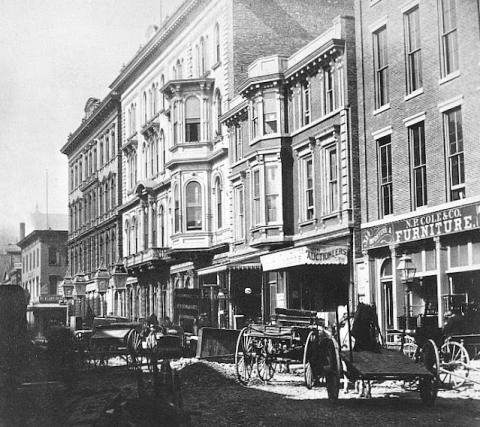In the spring of 1864 Maguire built another fine new theatre in San Francisco, on Pine Street just below Montgomery. In selecting this location, Maguire was following the already evident trend of theatrical interest southward toward Market Street. The older Opera House and Metropolitan, with entrances on right-angling streets, were semi-adjacent at a distance of a city block from old Portsmouth Square; but the newer Eureka was several blocks to the south, and now Maguire's Academy of Music was, again, semi-adjacent to this little theatre which Maguire had appropriated for a period.
Maguire’s new Academy of Music was the eleventh theatre Tom Maguire had erected on the Pacific Coast. Eight of these had been located in San Francisco, two in Sacramento, and one in Virginia City. All of these play-houses had been “elegant” in the manner of the day, but the Academy was designed to be the jewel of them all. Its cost, $66,000 exclusive of a lot priced at $30,000, represented a direct investment of cash, for in its construction Maguire followed a policy, unusual even in that day, of settling all bills punctually every week, so that his theatre was entirely paid for at the end of the three and a half months of construction.*
A reporter attached to the Call (Mark Twain was probably not yet in action, but had already joined or was within a few days to join its staff) reviewed the architecture of the Academy just before its opening to the public:
It has a marble front in imitation of the Italian style, and rises in four stories from the sidewalk. .. . The second story rests on twelve iron Corinthian columns, above which is a balustrade, crowned with a rich pediment supported on two elaborately carved columns. The third and fourth stories are highly ornamented with richly capped windows . .. and the building surmounted with a superbly chaste composite cornice. . . .Exquisite taste displayed throughout … resembles Niblo’s, in New York... . Seats...to be covered with scarlet plush. A celebrated painting, known as “The Age of Gold,” has been taken as a model for the drop-scene, or “act drop.” It will be larger and more elaborately executed than the well known dancing scene at Maguire’s Opera House and a greater number of figures will be introduced. . . . The ornamentation about the proscenium-boxes is extremely chaste and beautiful. Heavy Doric pillars of pure white, with golden ornaments, spring from the stage on each side of these gorgeous private boxes, while superb and costly drapery is tastefully disposed about their entrances... .
The walls are perforated with no less than sixty patent ventilators. . . . Light is obtained from a large and splendid chandelier, pendant from the dome. . . . Besides the fifty jets there contained, each tier of boxes [three in all] is fringed with a row of brilliant lights. …
No one could have foreseen the dismal failure of this beautiful but ill-fated playhouse. It is said that Maguire's wife was strongly opposed to its erection, as was his architect, Huling Majors.
Rodecape, Lois Foster. “Tom Maguire, Napoleon of the Stage.” California Historical Society Quarterly 21, no. 1 (1942): 39–74. https://doi.org/10.2307/25160979.
